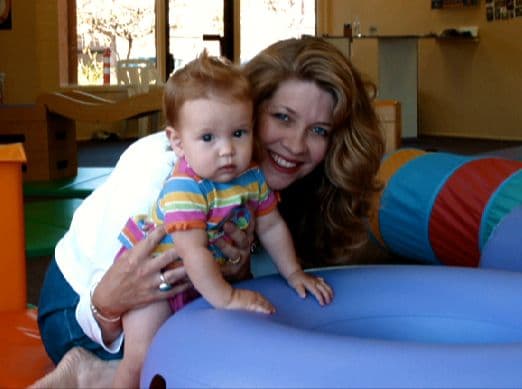
Last week’s article “Should Babies Be Allowed Screen Time?” offered hard guidelines for parents of babies and toddlers. I went right into the WHAT to do in response to the concerns parents come to me with. For some, that is sufficient. But for others, they want to know more WHY in order to feel confident about my recommendations.
This article offers a developmental psychology review/crash course outlining the developmental tasks children are trying to master between the first two years of their lives. With this information you can decide for yourself if screen time would enhance, be neutral, or interfere with your child’s development.
Brain Development
Brain imaging and recording technology has improved dramatically within the last decade, increasingly providing detailed evidence of brain changes throughout the developmental process. In general, the brain continues its remodeling process from infancy to adolescence, with different brain areas showing dramatic progressive change (neuronal growth) and later regressive change (neuronal elimination). This fine tuning results in more sophisticated abilities with age. (Brown).
The mind is a collection of mental modules (specific mental faculties tuned to particular types of environmental input). Each module must be stimulated in order to progressively develop. Therefore, nature (the child’s inherited brain hardware) develops in relation to nurture (experience of the environment). Developmental psychologists call this nature via nurture.
-
- Along with the increased number and variety of brain cells that grow during infancy, myelination will also continue throughout adolescence (Brown). Myelination is the process of sheathing axons (brain cells) with white matter to insulate them and allow them to conduct the electrical impulses that create “thinking.”
-
- In regard to the sequence brain structure maturation, remodeling appears to go from phylogenetically older to newer brain structures.
-
- As higher brain structures develop, we see neonatal reflexes disappear while others develop into more complex strings of behavior.
- In the first two weeks, babies are developing healthy respiration, circulation from the umbilical cord to the lungs, body temperature regulation, and feeding and elimination processes.
- From three weeks to twelve months, babies are acquiring self-regulated skills of locomotion (crawling and walking), manipulation (hand skills), and self-feeding with solid food. They are beginning to establish a sleep pattern and maintain a sleep–wake cycle, explore sound production in preparation for speech, and establish initial sensorimotor schemes and mastering object permanence. Over time, sleep and behavior patterns change and the baby will develop increasingly complex skills such as visual scanning, reaching and grasping, social smiling, self-soothing, crawling, and walking.
- As higher brain structures develop, we see neonatal reflexes disappear while others develop into more complex strings of behavior.
Cognitive & Motor Development
The work of developmental psychologists demonstrate that during the sensorimotor stage of development (0-2 years old), children must physically manipulate objects in a complex environment while simultaneously receiving instruction and stimulation from loving caregivers. With the child’s biological blueprint for learning already in place, environmental enrichment allows the baby to transition from being a reflexive being to mastering purposeful, goal-directed behavior. Parents show the baby how and what to think, slowly building the complexity of teaching with a delighted dance between baby and parent.
- Research demonstrates that children learn better in collaboration with others rather than alone. For example, children are more likely to engage in symbolic play if they are playing with somebody else rather than by themselves. The more sophisticated the child’s tutor in advancing the complexity of the play, the quicker the child’s skills advance. Working with another person increases the child’s motivation to learn, requires the child to articulate ideas, allows the child to build upon another’s increasingly complex cognitive strategies, and teaches the child how to understand the beliefs and feelings of others (build empathy).
- It has been hypothesized that babies have mirror neurons in multiple parts of the brain that facilitate imitation and learning. A mirror neuron fires both when an action is observed and when the action is actually executed. In other words, the neuron mirrors the other person’s behavior as if it was actually being carried out. Mirror neurons are thought to be a genetic advantage that allows us to anticipate and understand the actions of others prior to learning the activities ourselves, as if the baby was genetically primed for specific types of learning. Researchers believe that mirror neuron systems develop before 12 months of age and proactively facilitate the learning of empathy and language (Falck-Ytter).
Language Development
In order for young children to develop all aspects of language, they must have frequent conversational engagement with caregivers. Research shows that parents tend to create a supportive learning environment, starting with parentese (short, simple, high-pitched, repetitive sentences that is awesome at getting baby’s attention), with the parent gradually speaking with longer and more complex sentences just ahead of the child’s ability.
- Intonational prompts by the parent are often successful at affecting a baby’s mood and behavior.
- Children of parents who frequently expand, recast, and otherwise extend their children’s speech acquire complex speech more quickly.
-
- During their first year, a baby’s burgeoning familiarity with the phonological (sound) aspects of language is laying the foundation for language development.
- Newborns show preference for mom’s voice over any others.
- At 2-3 months, infants can distinguish consonant sounds.
- By 7 months, they have learned the first rule in pragmatics (social language) to not interrupt and wait for your turn to talk.
- By 8-10 months, babies use gestures and facial expressions to communicate and eventually pair with words and then sentences.
- During their first year, a baby’s burgeoning familiarity with the phonological (sound) aspects of language is laying the foundation for language development.
- Babies are active, rather than passive, learners and, therefore, thrive with interactive stimulation.
Emotional Development
Parental interaction has a profound impact on how emotions develop and what strategies are employed for emotional self-regulation. The better the “fit” between parent and child, the more secure the attachment and the better the child learns to regulate emotion.
- Babies develop various emotions in their first two years of life, all of which are highly influenced by how parents react. Young children gradually shift from relying on caregivers for emotional regulation to self-regulation.
- By 6 months old, infants have learned some regulation by turning away or seeking objects to suck with boys being more likely to elicit soothing from caregivers than girls.
- At 12 months, infants will rock, chew on objects, or move away to soothe.
- By 18-24 months, we see toddlers requesting action from caregivers, distracting themselves, and actively suppressing anger or sadness.
- There is even evidence that 12-month olds avoid and react negatively to an object that elicited a fearful reaction of an adult on TV. Watch out parents, even teeny-tiny ones are affected by programming choice!
- A critical contributor to healthy attachment is the bidirectional, synchronized routines that parents and infants establish over the first few months of the baby’s life. Even as young as two months, babies will show distress by a parent’s lack of emotional responsiveness. (Is it fair to think the child would be distressed watching a nonresponsive character on a screen?) With the coordinated, consistent dance between parent and child, babies learn how to trust the world and build self-regulation. Babies use animated social and verbal expressions, like smiling and crying, to communicate as well as to respond to caregiver expressions and verbalizations. This skill is called social referencing. Babies do best with attentive, delighted, patient caregivers who are present and consistently engaged. The more practiced the dance routine, the better the caregiver and baby get at interpreting each other’s signals and making necessary adjustments, eventually blooming into a mutually satisfying strong reciprocal attachment. The more quality time a caregiver spends developing the dance, the healthier the attachment.
- Attachment occurs in four phases:
- 0-2 months – undiscriminating social responsiveness (baby orients to all humans),
- 4-5 months – discriminating social responsiveness (recognizes familiar people and becomes anxious with strangers),
- 7 months – active proximity seeking (actively seeks contact with familiar people),
- 3 years – goal-corrected partnership (has learned to predict the behaviors of primary caregivers and adjusts own behavior to maintain physical closeness) (Bowlby).
- Inconsistent caregiving due to depression or other caregiver characteristics (history of abuse, unhappy marriage, poverty-stricken, overwhelmed, substance abuse, etc.) are more likely to result in resistant attachment and a child who is clingier, cries, and gets angry in his effort to get emotional support and comfort. Other unhealthy attachment styles result from rigid, self-centered caregiving characterized by impatience, unresponsiveness, and negative feelings about the infant or from overzealous parents who provide too much intrusive stimulation (avoidant attachment). Disorganized/disoriented attachment (also unhealthy) results when the child has experienced neglect or abuse. And to make things even MORE complicated, child temperament and the “fit” between mother and child is the primary contributor to how the insecurely attached child responds to his caregiver.
-
- The more secure the attachment, the better the child is at complex and creative problem solving and symbolic play, demonstrates more positive emotions, and is judged by others as more attractive.
- During toddlerhood, children are learning to develop autonomy versus shame and doubt. During toddlerhood, we see primarily parallel play with peers (playing next to each other rather than with each other) progressing into more complex interactive socialization. With play, toddlers explore personal boundaries and are starting to develop a conscience.
It’s been awhile since most of us had a developmental psychology class. There’s no better time to review this information than while you’re in the middle of shaping your perfect, tiny little human. I hope this justifies your heroic efforts to manage screen media effectively with your family. I know it gets harder by the year! If you know other caregivers who may like a brush-up, do me a favor and pass it on! To get the free article download “Three Powerfully Effective Ways to Get Your Kids Internet Safe”, click here.
I’m the mom psychologist who will help you GetYourKidsInternetSafe.
Onward to More Awesome Parenting,
Tracy S. Bennett, Ph.D.
Mom, Clinical Psychologist, CSUCI Adjunct Faculty
GetKidsInternetSafe.com
Works Cited
American Academy of Pediatrics Council on Communications and Media Executive Committee
Bartzokis, G. (2005). Brain Myelination in Prevalent Neuropsychiatric Developmental Disorders: Primary and Comorbid Addiction. Adolescent Psychiatry, 29, 55-96.
Bowlby, John. Attachment and Loss. New York: Basic, 1982. Print.
Brown, Timothy T., and Terry L. Jernigan. “Brain Development During the Preschool Years.” Neuropsychology Review 22.4 (2012): 313-33. Web.
C.S. Mott’s Children’s Hospital National Poll on Children’s Health
Falck-Ytter, Terje, Gustaf Gredebäck, and Claes Von Hofsten. “Infants Predict Other People’s Action Goals.” Nature Neuroscience Nat Neurosci 9.7 (2006): 878-79. Web.
Goswami, U. (2015). Children’s Cognitive Development and Learning. Research Reports: CPRT Research Survey 3 (new Series). http://cprtrust.org.uk/wp-content/uploads/2015/02/COMPLETE-REPORT-Goswami-Childrens-Cognitive-Development-and-Learning.pdf
https://kaiserfamilyfoundation.files.wordpress.com/2013/04/8010.pdf
Mumme, D., & Fernald, A. (2003). 12-month olds avoid and react negatively to an object that elicited a fearful reaction of an adult on TV. Child Development, 74(1), 221-237.
Piaget, J. (1952). The childs conception of number. London: Routledge & Kegan Paul.
Because giggling babies NEVER gets old:
Don't worry, we will never spam you.










